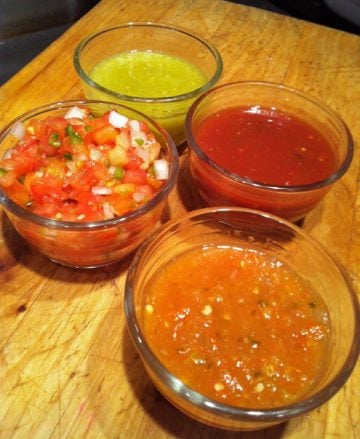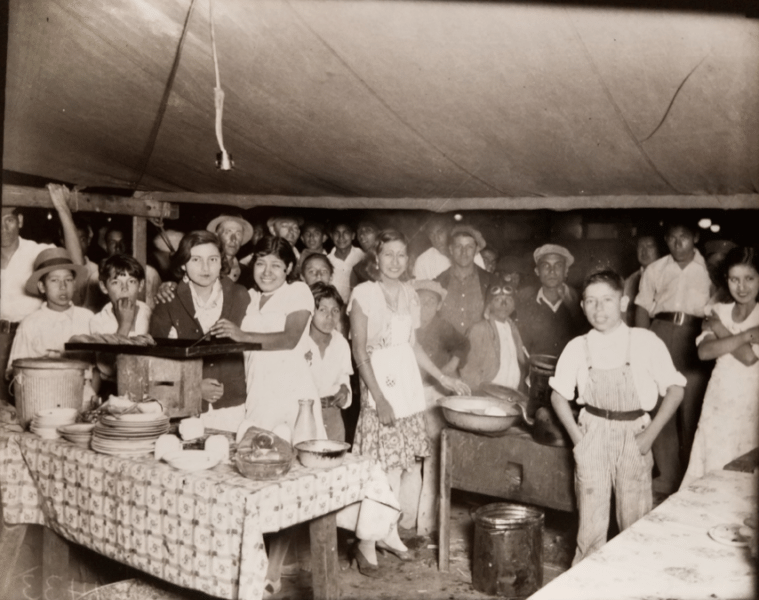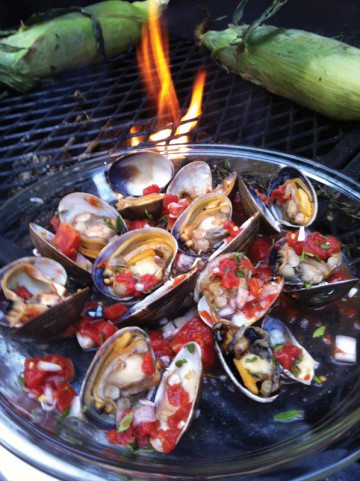Beyond Tex-Mex: Rediscovering Texas’ 10,000-Year-Old Cuisine

*It’s not Tex-Mex, it’s Texas-Mexican – there’s a difference. The culinary roots go back 10,000 years. VL
![]() By Adan Medrano, The Texas Observer (10 minute read)
By Adan Medrano, The Texas Observer (10 minute read)
Growing up, I remember my amá making corn tortillas by hand. Mom would flip a ball of corn masa back and forth between her hands, fashioning it into a perfectly round thin disk. Then she’d roll it off her palm onto a hot comal, a cast-iron griddle. It sizzled.
I remember apá seated at the table, taking a big bite from a green, plump serrano chile that lay next to jicama, carrots and radishes. He was enjoying a fish soup that had chunks of tomato, and behind him, on the stove, steam rose from a skillet of carne guisada, my favorite beef stew.
These are memories of Texas Mexican food. It is a style of cooking, a collection of recipes, a cuisine of and by the Mexican-American community of Texas, whose ancestors are the Native Americans who first lived here over 12,000 years ago. Though the traditions of the Tejas, Karankawa, Coahuiltecan and other indigenous communities are largely forgotten in the popular imagination, their style of cooking endures, a vibrant cuisine served every day in homes and small cafes across Texas. But in the public culinary landscape it is invisible, due mainly to ill-informed food writers and kitchens that do not give credit where credit is due.
When I attended the Culinary Institute of America in San Antonio, I enjoyed studying and cooking food from France, the Mediterranean, Argentina, Peru, Brazil and Mexico, but I found it strange that we did not study the food that I enjoyed at home. I wanted to delve into the salsas, tortillas, shrimp cakes, pasta/fideo and seafood stews that my mother learned from her mother and grandmother.
While learning about dishes from Oaxaca and Yucatán, Mexico, I asked myself how the food of my family and ancestors could be completely invisible. My mostly Mexican-American classmates and I questioned why the cooking style we grew up with was invisible in the mainstream culinary scene.

This invisibility is due partly to the many food writers who ignore us in their reporting. Likely because they are almost exclusively from outside the Mexican-American community, they are uninformed about the history and the nuances of the Mexican food indigenous to Texas. Meanwhile, Tex-Mex — a much younger cuisine that was popularized by Anglos — is dominant. Tex-Mex is a distinct tradition in its own right, beloved by millions. But when we forget Texas’ first food, we also forget our history.
Texas Mexican cuisine cannot be described as “south-of-the-border.” One of a variety of regional Mexican styles of cooking, such as Oaxaca Mexican and Puebla Mexican, it developed north of the Rio Grande long before the river became a border. Texas Mexican didn’t cross the border, the border crossed it — and in doing so helped erase its history. Evidence of ancient cooking techniques can be found all across Texas, including San Antonio, where near the Olmos Dam archaeologists have uncovered a 4,000-year-old earth oven. The collective evidence indicates that humans have continuously inhabited what is today San Antonio for at least 10,000 years and probably 15,000 years.
Because these original Texans were hunters and gatherers, Texas Mexican cooking is intrinsically local and seasonal. Chiles are essential, selected more for their flavor, color and aroma than for heat. Roots and vegetables are integral, as are pinto beans, though unlike in Tex-Mex, they are pan-roasted and stewed with very little grease. Deer, quail, ducks and turkeys abound, as do seafood and fresh fish.
When Anglo settlers arrived in Texas, they overlooked this food even as they enjoyed and profited from it. In the 1880s, indigenous businesswomen, who were expert cooks, sold food at open-air stands in downtown San Antonio. It was casero, home-cooking: carne con chile, beans, enchiladas, tamales, chile verde and tortillas. The food was so delicious that the women and their stands transformed the city’s center into a tourist destination.Newspaper writers of the day labeled these entrepreneurial women “chili queens,” a term which to this day many Mexican Americans find offensive. In his book Planet Taco, historian Jeffrey Pilcher explains that “Like the loyal Southern ‘mammy,’ the chili queen served to naturalize racial hierarchies and justify white domination.” It was a stereotype that was good for tourism. They were sirens serving delicious food for a night of enjoyment. It eroticized indigenous women, depicting them as seducers, sexually perverse, dangerous and unclean.
The special collections library at the Institute of Texan Cultures in San Antonio houses an assortment of “chili queen” photographs published in newspapers of the time. Many of the photographers’ notes include the names of the cooks, yet not once did the writers see fit to include those names. Nor did any newspaper note the differences in recipes, techniques and flavors that distinguished one chef from another.

Though these cooks boosted the San Antonio economy, they were not appreciated by the business and political establishment. The health department eventually forced the women to envelop their stands with screen mesh, as a way of protecting the city from their perceived uncleanliness. After years of debate, the women were expelled from the city center in the early 1940s. On the surface, the arguments were about safety and cleanliness, but to the Anglo immigrants of Texas, the idea of Mexican food and of Mexicans was a transgression, though an enticing one. This story shows how the forces of gender inequality and ethnic exclusion play out in the food industry — a reality we still live with today.
Chefs are used to being interviewed by food writers, but most find it hard to explain what their food says about them, their culture and their ethics. Food writers, who tend not to be a very diverse crowd, draw only from their limited experiences when interpreting a dish. Many repeat the mistake made by British cookbook author Diana Southwood Kennedy. Kennedy visited Central and Southern Mexico and settled into a preference for those regional cuisines. Northeastern Mexico and South Texas remain terra incognita to her. In her cookbook, she admits she had no idea chile con queso was Mexican until she saw it served in Coahuila. Likewise, many food writers wrongly call our food “south-of-the-border” or say that it is Mexican food married to Anglo sensibilities. These statements are widely repeated, though they have no historical basis. Just because you like it doesn’t mean you originated it.
Thankfully, a growing number of Mexican Americans are, at long last, writing with an insider perspective about family recipes and casero-style cooking. Among them is Sylvia Casares, the “Enchilada Queen,” a celebrity chef and much-acclaimed Houston restaurateur. Casares did not choose her moniker. A food writer first called her by that name in 2004 and, as Casares says, “the name stuck.” She spun the term to her marketing advantage and wholeheartedly embraces it.Hailing from Brownsville, Casares is one of many chefs today who claim this land as their native home and are giving it fresh culinary expression. Her focus is on fresh ingredients and vibrant flavors (“We don’t cheese everything up,” she says), and the menu at Sylvia’s Enchilada Kitchen features sauces from McAllen and Crystal City, Monterrey and Chihuahua. “No sleepy flavors, please!” she says. “I like to honor and give credit to the classic recipes of my mom, my grandmother, and all mothers, aunts and grandmothers who prepared this food for us.”
There are also other voices that, writing from an outsider perspective, take the time to delve into family stories and techniques, and thus shed light on the Mexican cuisine of Texas. J.C. Reid in Houston, MM Pack in Austin and Kim Pierce in Dallas are among those whose research leads them to make cultural links and to credit chefs who otherwise would not be noticed.

Chicana and Chicano line cooks, long unsung and invisible, are eschewing that line and becoming chef/owners. They follow in the trailblazing footsteps of the venerable Mexican restaurateurs of the 1900s, the champions of Texas Mexican food such as Felix Tijerina and Ninfa Laurenzo of Houston; Viola Barrios, Pete and Cruz Cortez of San Antonio; Matt Martinez of Austin; and Adelaida Cuellar and Larry Guerrero of Dallas, among many others. Their family style cuisine thrives in Texas barrios, but in the mainstream, where the money is, it has often been co-opted by those with more economic, social and political standing.
No one recorded the names of the line cooks who helped Dean Fearing take on the title “Father of Southwestern Cuisine,” given to him by food writers. In a 2003 D Magazine interview, Fearing confesses that when he decided to concentrate on Southwest cuisine, he relied on his Mexican-American line cooks. “We had to learn about all the fresh and dried chilies and how to handle lime juice and mangoes,” Fearing said. “I learned about all this stuff from the line cooks.”
With the mention of only Amador Mora, Fearing’s sous chef, the D Magazine writer says no more about this team of line cooks. Their names are lost to history.
Read more stories like this in NewsTaco. >>
“We need more chef/owners,” says San Antonio chef Johnny Hernandez of La Gloria, The Fruteria and El Machito. He is part of the new vanguard of Texas Mexican chefs who rely on memory and family traditions, and who emphasize that hospitality is the context for their food.
The guiding triad is “familia, cultura y comida” (family, culture and food), says Michael Cortez, a third-generation member of the Cortez family, owners of Mi Tierra in San Antonio, founded in 1941. He finds it unthinkable to ignore the link that any recipe, old or new, has with family cooking traditions. Also unthinkable is to disassociate food from culture. “Todos comemos de la misma tortilla” (We all eat from the same tortilla) is the slogan heard among the staff of Mi Tierra. Through food we are all bound together.
We renew by remembering. San Antonio chef David Arciniega of Amaya’s Tacos serves flour tortillas that are handmade in front of you. He uses only vegetable fats, and sparingly. When he flavors pinto beans, he never uses bacon or lard, but prefers root vegetables such as onions and carrots — paying tribute to pre-1500 flavors, as well as to 1830, when his great-great-great-great grandfather was mayor of San Antonio. “We want to reclaim our lost land and culture,” he says, “and that’s why we opened this little restaurant and are cooking for our community.” Vegan dishes are on his menu, a hearkening back to the native techniques of pounding pine nuts, berries and herbs to make dried pellets, the precursors of today’s energy bars.
All food is memory, and Texas Mexican food has nourished and celebrated the Mexican-American community of Texas for centuries. My dad biting into a serrano chile and my amá crafting corn tortillas are memories that are shared widely in families and barrio restaurants throughout Central and South Texas. When this cuisine is honestly studied, reported and honored, we will better understand Texas history, foodways and cultural differences. As a cook, I believe that those differences are what ultimately make for new, creative and delicious dishes that can be enjoyed at a table where we are family and all are welcome.
This article was originally published in The Texas Observer.
[Photos courtesy of The Texas Obsaerver]

